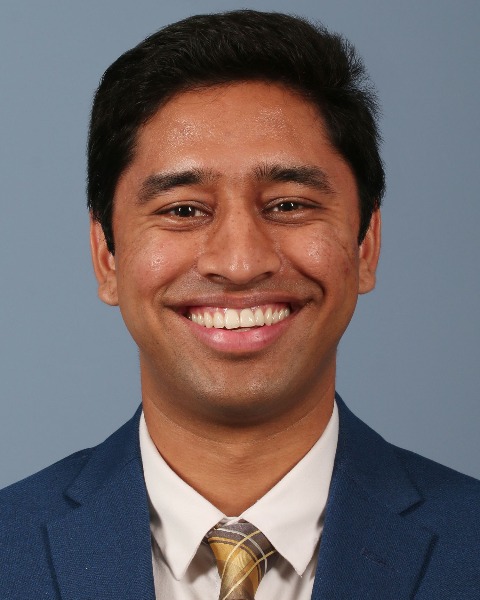Abstract Session
Rapid Fire Research Forum
(AS2) Comparing Patient Outcomes After Cervical Spine Surgery for Myelopathy vs. Combined Myeloradiculopathy with 1- and 2-year Follow-up: A Multi-institutional Study Using the QOD Registry
Monday, April 24, 2023
7:30am - 7:35am PST
Location: Los Angeles Convention Center, 406AB

Rushikesh S. Joshi, MD
Neurosurgery Resident
University of Michigan
Ann Arbor, Michigan, United States
Presenting Author(s)
Disclosure(s):
Rushikesh S. Joshi, MD: No financial relationships to disclose
Introduction: Myelopathy can cause diverse and debilitating symptoms, with outcomes assessed primarily using patient-reported outcomes (PROs).
Methods: The prospectively collected Quality Outcomes Database was used to compare outcomes between myelopathy and myeloradiculopathy patients at 1- and 2-years using the mJOA, EQ-VAS, and NDI surveys.
Results: 889 patients were included in the study (510 myelopathy, 379 myeloradiculopathy). Myeloradiculopathy patients presented with significantly more weakness (47.5% vs. 12.4%, p< 0.001), arm pain (71.8% vs. 0.0%, p< 0.001), numbness (78.1% vs. 35.5%, p< 0.001) and neck pain (79.2% vs. 42.2%, p< 0.001). Surgical approach for myeloradiculopathy patients differed significantly (75.2% posterior/24.8% anterior approach vs. 60.0% posterior/40.0% anterior approach, p=0.001) as did use of foraminotomy (24.4% vs. 6.5%, p< 0.001) compared to myelopathy patients.
Overall, 83% of patients completed 2-year follow-up for NDI, 76% for EQ-VAS, and 68% for mJOA scores. Myelopathy patients demonstrated significant improvements: baseline mJOA to 1-year (11.9 ± 2.8 vs. 13.6 ± 2.8, p< 0.001; 13.9 ± 2.7 at 2-years, p< 0.001), baseline EQ-VAS to 1-year (60.3 ± 21.8 vs. 70.1 ± 19.9, p< 0.001; 69.5 ± 22.1 at 2-years, p< 0.001) and baseline NDI to 1-year (34.0 ± 20.65 vs. 18.6 ± 18.1, p< 0.001; 18.1 ± 17.3 at 2-years, p< 0.001). Myeloradiculopathy patients similarly demonstrated improvement: baseline mJOA to 1-year (12.3 ± 2.8 vs. 14.2 ± 2.5, p< 0.001; 14.2 ± 2.5 at 2-years, p< 0.001), baseline EQ-VAS to 1-year (58.9 ± 22.2 vs. 70.5 ±21.3, p< 0.001; 68.8 ± 23.8 at 2-years, p< 0.001) and baseline NDI to 1-year (41.3 ± 20.9 vs. 21.2 ± 20.6, p< 0.001; 21.0 ± 20.0 at 2-years, p< 0.001).
Conclusion : Myelopathy and myeloradiculopathy patients demonstrated similar improvements in all PROs at 1-year and 2-years. Myeloradiculopathy patients underwent more foraminotomy and posterior cervical surgery. Appropriate surgical intervention leads to sustained clinical improvement in both patient groups.
Methods: The prospectively collected Quality Outcomes Database was used to compare outcomes between myelopathy and myeloradiculopathy patients at 1- and 2-years using the mJOA, EQ-VAS, and NDI surveys.
Results: 889 patients were included in the study (510 myelopathy, 379 myeloradiculopathy). Myeloradiculopathy patients presented with significantly more weakness (47.5% vs. 12.4%, p< 0.001), arm pain (71.8% vs. 0.0%, p< 0.001), numbness (78.1% vs. 35.5%, p< 0.001) and neck pain (79.2% vs. 42.2%, p< 0.001). Surgical approach for myeloradiculopathy patients differed significantly (75.2% posterior/24.8% anterior approach vs. 60.0% posterior/40.0% anterior approach, p=0.001) as did use of foraminotomy (24.4% vs. 6.5%, p< 0.001) compared to myelopathy patients.
Overall, 83% of patients completed 2-year follow-up for NDI, 76% for EQ-VAS, and 68% for mJOA scores. Myelopathy patients demonstrated significant improvements: baseline mJOA to 1-year (11.9 ± 2.8 vs. 13.6 ± 2.8, p< 0.001; 13.9 ± 2.7 at 2-years, p< 0.001), baseline EQ-VAS to 1-year (60.3 ± 21.8 vs. 70.1 ± 19.9, p< 0.001; 69.5 ± 22.1 at 2-years, p< 0.001) and baseline NDI to 1-year (34.0 ± 20.65 vs. 18.6 ± 18.1, p< 0.001; 18.1 ± 17.3 at 2-years, p< 0.001). Myeloradiculopathy patients similarly demonstrated improvement: baseline mJOA to 1-year (12.3 ± 2.8 vs. 14.2 ± 2.5, p< 0.001; 14.2 ± 2.5 at 2-years, p< 0.001), baseline EQ-VAS to 1-year (58.9 ± 22.2 vs. 70.5 ±21.3, p< 0.001; 68.8 ± 23.8 at 2-years, p< 0.001) and baseline NDI to 1-year (41.3 ± 20.9 vs. 21.2 ± 20.6, p< 0.001; 21.0 ± 20.0 at 2-years, p< 0.001).
Conclusion : Myelopathy and myeloradiculopathy patients demonstrated similar improvements in all PROs at 1-year and 2-years. Myeloradiculopathy patients underwent more foraminotomy and posterior cervical surgery. Appropriate surgical intervention leads to sustained clinical improvement in both patient groups.
